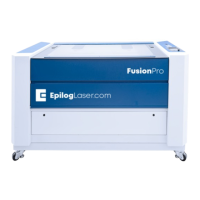Fiber Laser Materials/Techniques
The fiber laser can etch and mark a wide variety of metals and plastics. Below are a few techniques for
creating dierent marks including annealing, polishing and etching into metals, as well as information
on plastic marking with the fiber laser.
Metal Annealing
Annealing can be done on most metals that contain high levels of carbon and metal oxides. These are
generally, but not limited to, steel alloys, iron, titanium, cobalt, molybdenum, and chrome-plated iron/
steel. To anneal, you must use a slow rate of speed to heat and change the suace color of the material,
but a higher wattage fiber laser will help reduce the cycle times.
To change the suace color without penetrating the metal, the laser beam’s focal point is crucial in
achieving a dark mark. An annealed mark is accomplished with the focal point up (closer to) .070” to
.110” (1.778 to 2.794 mm) or down (further away) -.060” to -.090” (-1.524 to -2.286 mm) from zero. Adjusting the
speed, focus and frequency setting will vary the contrast of mark generally resulting in shades of blue,
purple and black.
The frequency is the amount of laser power per pulse. The lower the frequency, the more burst of power
is being applied. Because we’re intentionally applying a broader beam of laser light to achieve an
annealed mark, frequency is almost always set in the lower 1-5% range.
For best results, print at 600 DPI. 1200 DPI should be considered for metals that are more diicult to
anneal, if there is inconsistent color change at the recommended settings, or when cycle times aren’t a
concern. The extra overlapping of pixels oered at 1200 DPI will assure a deeper, darker mark.
Metal Etching
Deep metal engraving is a common application for the fiber laser. Using a slow speed setting doesn’t
necessarily equate to depth. Longer laser dwell time typically results in more eruption of metal, leaving
a raised mark instead of deep penetration.
We find for the best deep metal etching, moderate speed settings (20-30%) and more passes slowly
chip away at the metal for a better mark. Deep metal engraving requires maximum wattage. For these
applications, a 30 or 50-watt fiber laser is recommended.
Frequency is generally set between the 1-5% range. A lower frequency range provides more bursts of
laser power per pulse and is crucial to ablating the metal. We’ve found that focusing “into” the metal by
.010” to .030” (.254 to .762 mm) helps in the removal of metal. No technical data is available on whether
refocusing aer each pass is helpful or not. To better assist in removing metal cleanly, higher resolution
(1200DPI) with more overlap of laser pulses tends to provide a cleaner, more defined etch.
Deep engraving will require multiple passes, which can be easily accomplished by changing the number
of copies in the print dialogue box for CorelDRAW. As with all materials including metals, the hardness
or grade will ultimately determine what settings and how many passes are needed to achieve a certain
depth. Use the guidelines above as starting points and experiment for best results.
- 193 -
SECTION 12: ENGRAVING MATERIALS

